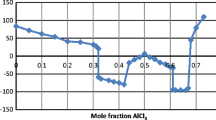Abstract
The cause of the appearance of a minimum in the molar electrical conductivity in many electrolyte solutions with increasing electrolyte concentration, in solvents of low dielectric permittivity, is reviewed. Tentative explanations include the formation of triple ions or, alternatively, changes in the electrical polarization of the solutions due to the presence of electrolyte ion pairs. Theoretical models for linear triple ions and apolar dimers are examined. Experimental evidence favors the polarization hypothesis over triple ions; the presence of a maximum in the dielectric permittivity with increasing electrolyte concentration is consistent with the presence of an equilibrium between ion pairs, AB, and their dimers, A2B2, at higher concentrations.
Similar content being viewed by others
References
Fuoss, R.M., Kraus, C.A.: Properties of electrolytic solutions. IV. The conductance minimum and the formation of triple ions due to the action of Coulomb forces. J. Am. Chem. Soc. 55, 2387–2399 (1933)
Kraus, C.A., Fuoss, R.M.: Properties of electrolytic solutions. I. Conductance as influenced by the dielectric constant of the solvent medium. J. Am. Chem. Soc. 55, 21–36 (1933)
Marcus, Y., Hefter, G.: Ion pairing. Chem. Rev. 106, 4585–4621 (2006)
Weingartner, H.: Corresponding states for electrolyte solutions. Pure Appl. Chem. 73, 1733–1748 (2001) and references cited therein
Sukhotin, A.M., Timofeeva, Z.N.: Ion association in solutions. III. Potentiometric ion activity determination in solutions of low dielectric constants. Zh. Fiz. Khim. 33, 1739–1743 (1959)
Cavell, E.A.S., Knight, P.C.: Effect of concentration changes on permittivity of electrolyte solutions. Z. Phys. Chem. 57, 331–334 (1968)
Petrucci, S., Eyring, E.M.: Multibody interaction theory of triple ions and dimerion pairs. J. Phys. Chem. 95, 1731–1736 (1991)
Fuoss, R.M., Hsia, K.-L.: Association of 1-1 salts in water. Proc. Nat. Acad. Sci. USA 57, 1550–1557 (1967)
Kenausis, L.C., Evers, E.C., Kraus, C.A.: Mechanisms underlying the equilibrium reactions between ions and ion-pairs in solutions of electrolytes. I. Solutions in p-xylene at 52 °C and benzene at 25 °C. Proc. Nat. Acad. Sci. USA 48, 121–128 (1962)
Kenausis, L.C., Evers, E.C., Kraus, C.A.: Mechanisms underlying the equilibrium reactions between ions and ion-pairs in solutions of electrolytes II. The effect of temperature. Proc. Nat. Acad. Sci. USA 49, 141–146 (1963)
Petrucci, S., Eyring, E.M.: Microwave dielectric relaxation, electrical conductance and ultrasonic relaxation of LiClO4 in polyethylene oxide dimethyl ether-500 (PEO-500). Phys. Chem. Chem. Phys. 4, 6043–6046 (2002)
Gibbs, J.W.: The Collected Works of J. Willard Gibbs. Longmans, Green and Co, New York (1928)
Friedman, H.L.: Electrolyte Solutions. In: Eyring, H., Christensen, C.J., Johnston, H.S. (eds.) Ann. Rev. Phys. Chem. 12, 171–194 (1961)
Levin, Y., Fisher, M.E.: Criticality in the hard-sphere ionic fluid. Physica A: Stat. Theor. Phys. 225, 164–220 (1996)
Falkenhagen, H., Ebeling, W.: In: Petrucci, S. (ed.) Ionic Interactions, vol. 1. Academic Press, New York (1971)
Ebeling, W.: Theory of the Bjerrum ion association in electrolytes. Z. Phys. Chem. 238, 400–402 (1968)
Author information
Authors and Affiliations
Corresponding author
Rights and permissions
About this article
Cite this article
Petrucci, S., Masiker, M.C. & Eyring, E.M. The Possible Presence of Triple Ions in Electrolyte Solutions of Low Dielectric Permittivity. J Solution Chem 37, 1031–1035 (2008). https://doi.org/10.1007/s10953-008-9285-z
Received:
Accepted:
Published:
Issue Date:
DOI: https://doi.org/10.1007/s10953-008-9285-z




